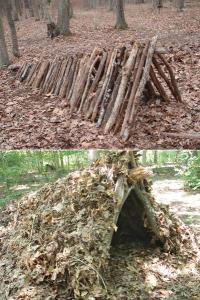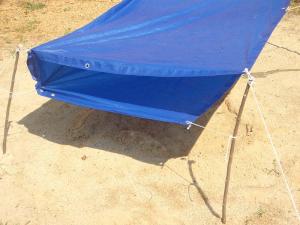Shelter Me
Shelter is one of the top needs we must address when it comes to survival. There are many ways to construct a shelter. I’m going to cover a couple I find easiest to build and talk about a couple key points to consider when building any shelter. First, perhaps the most important thing is to get your body off the ground. You can either build a platform or cut boughs of soft pine or moss bed to lay down. Try to make this layer thick – at least three inches. When selecting the boughs it’s tempting to cut your work by taking a large branch with many sprigs of pine, but this will in the end not be as comfortable because there’s usually too much branch making the bedding hard and lumpy. Make sure you build this layer a little longer than your body and one and a half to two times your body width.
When selecting a place to build your shelter look at the terrain. Envision how the water will follow the contours of the geography you are in, do not build your shelter in the V of two inclines. If it rains you will be sleeping in a river… and not for long. Take a look over your head, look at the trees and see if there are any dead limbs. I’ve found many “Perfect Camping Spots” which I’ve had to abandon because of dead limbs, called “Widow Makers” hanging over the spot which was perfectly level and with the most incredible view. Widow Makers have killed many a backpacker and should be avoided at all costs. I don’t care how cold, tired and hungry you are. At 2 o’clock in the morning when the wind picks up that limb will end your life, or worse trap you with a broken back in the middle of no where. There’s nothing worse than making a bad situation hopeless.
After selecting your spot look around and study the topography. Do the trees all lean in one direction from the wind? There’s no telling which way the winds will actually blow, but you can guesstimate based on the topography. If there’s a large boulder you can build up against, it’s a pretty sure bet the wind won’t blow through the rock. There are several styles to choose from – the basics are the Lean To, the A Frame and the Tee Pee (or Wickiup). From these three you can upscale and become very inventive.
The Lean To is perhaps the simplest shelter to build.  It uses a horizontal structure across the top and limbs leaning up against it to give it structure, once the structure is in place use smaller limbs and leaves to allow water to shed off the backside of the shelter and also creating a layer of insulation. Remember to layer the leaves and boughs from the bottom to the top with the layers pointing down. This will allow run off downward. If you point them up it’s more likely to create leaks.
It uses a horizontal structure across the top and limbs leaning up against it to give it structure, once the structure is in place use smaller limbs and leaves to allow water to shed off the backside of the shelter and also creating a layer of insulation. Remember to layer the leaves and boughs from the bottom to the top with the layers pointing down. This will allow run off downward. If you point them up it’s more likely to create leaks.
The A Frame can be a little more time consuming, but uses the same principals as the Lean To. If you create a triangle with three large supports you can then layer branches from the opening to the bottom of the shelter. This creates a much more insulated and weather resistant shelter. 
The Tee Pee can be built much larger and when designed correctly can have a fire in the inside in the center because there will be a natural chimney created when all the logs are leaned onto one another. Air will vent into the structure and the smoke will rise through the top. Many people have lived very comfortable for extended periods in a Tee Pee in extremely cold temperatures. Remember to layer the material over the outside of the structure in the same fashion, so water will roll off the outside like shingles00 on a house. 
A couple things to think about when building the shelter are that if you are building a shelter in the heat you want to create two layers above you to help cool you and create shade from the sun. Here is a good example of this:
The space between the two layers will become a little cooler and help keep your temperature down.
If you have a clear sheet of plastic and an emergency blanket you can make a convection shelter very simply. If you build an A Frame shelter facing a fire, line the back side of the shelter with the thermal blanket, this will reflect the heat from the fire. Over the front of the shelter lay the plastic as if it were a glass door over the entire front. Remember to build your fire as long as the width of the front of the opening about 24″ away. I have heard of shelters using the principles of convection keeping the inside at 70 degrees when the outside temperatures have plummeted down into the 20’s. It should look something like this:
Now knowing the principles of these three basic structures you can improvise and use other materials like tarps or ponchos. Look for natural features to aid you in building your shelter, it’ll always take longer than you thought and be a lot more labor than you estimate, so get a good head start before the sun goes down.
